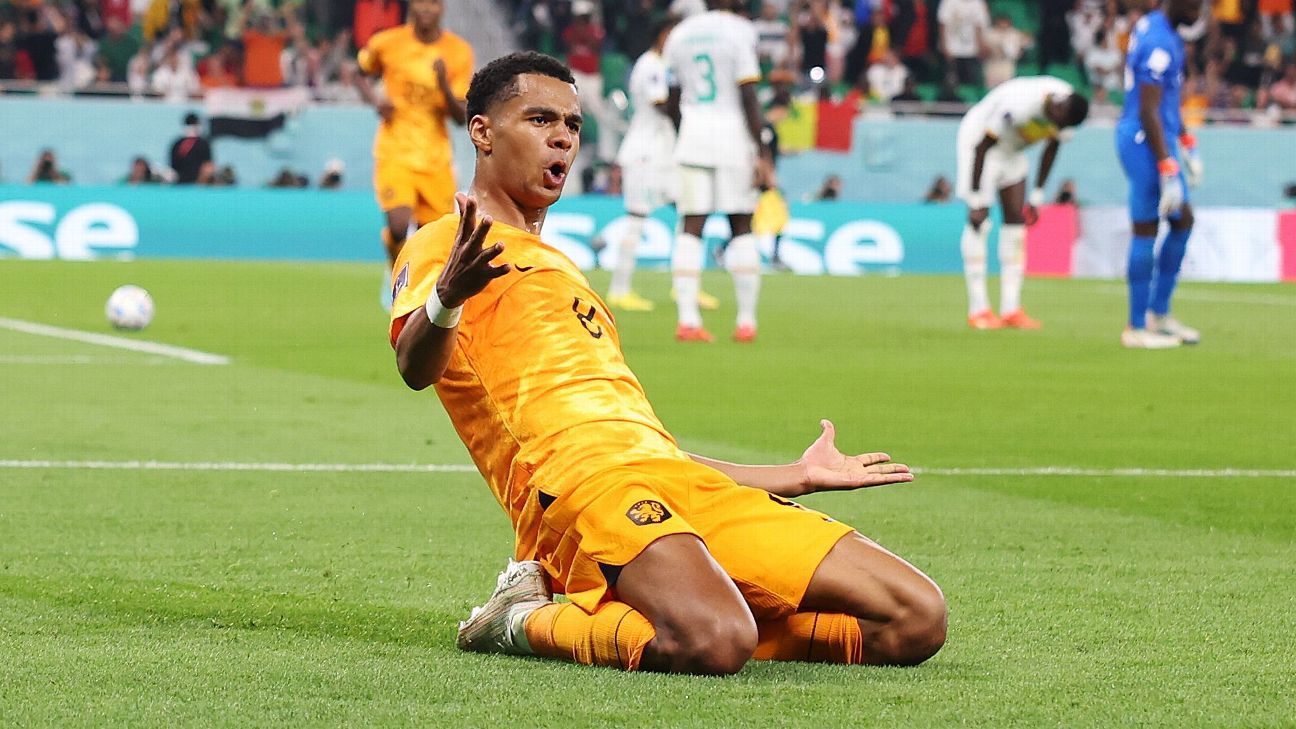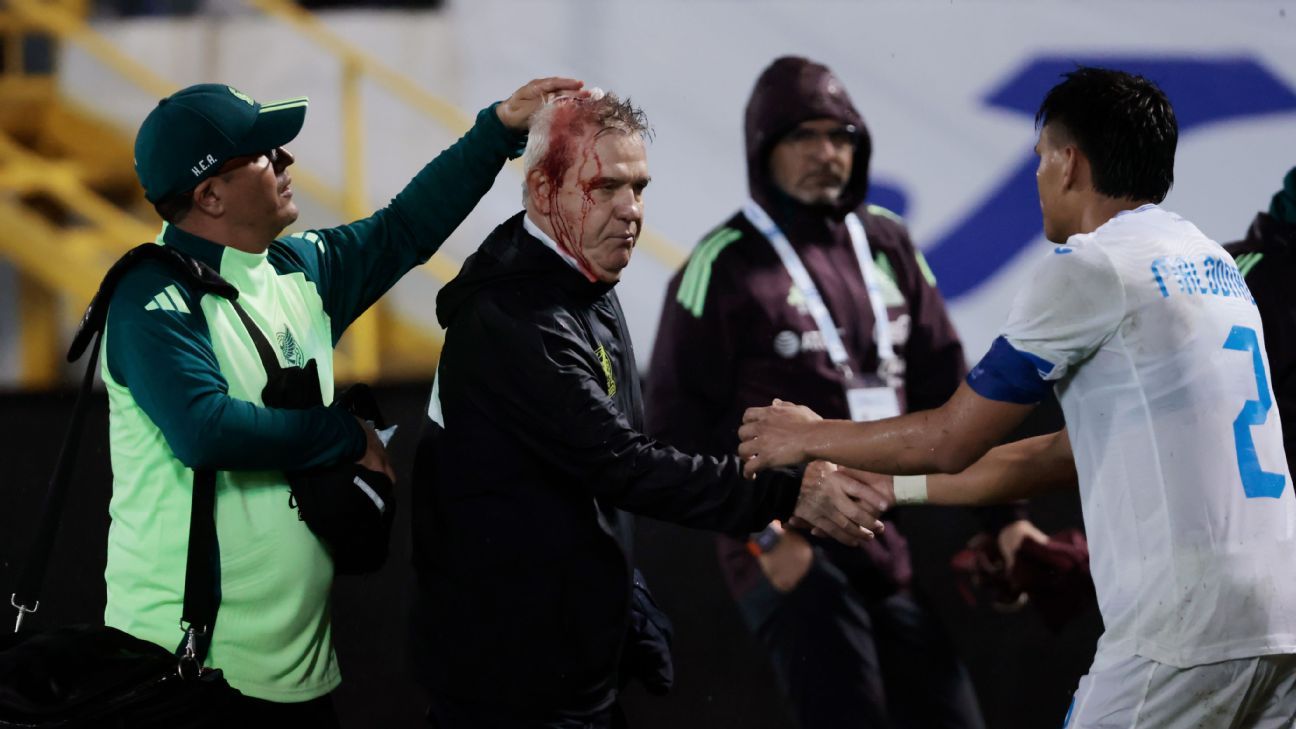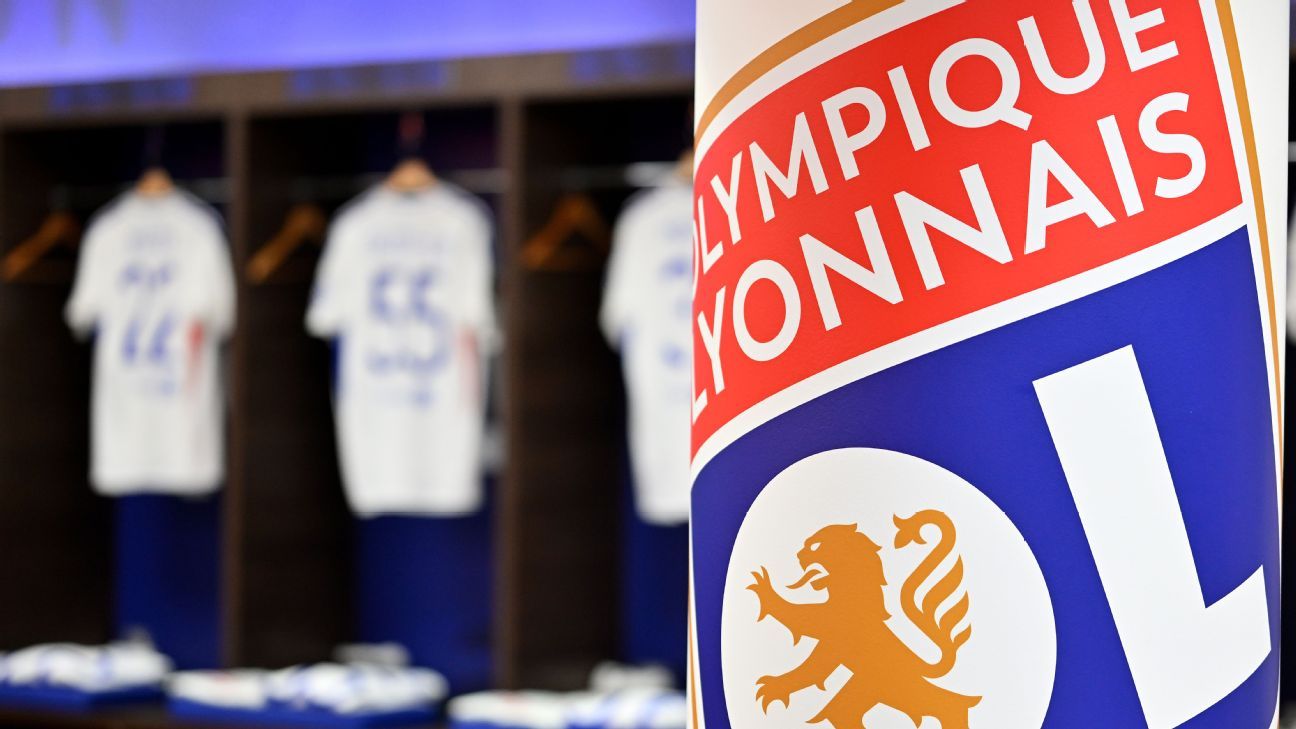
With six minutes to play amid the Qatar heat and the beating drums, Netherlands were toiling as they tried to break the deadlock against Senegal in their tense 2022 World Cup opener. A goal looked unlikely as the Dutch couldn't find a weakness in the chain of white shirts wrapped around the edge of the 18-yard box. Then, the ball broke to Frenkie de Jong.
As the Barcelona midfielder looked up and got the ball out of his feet, Cody Gakpo bolted in from the right wing, slipped in between the ball-watching defenders as they stepped up. Just as goalkeeper Edouard Mendy came to clear with his fists, Gakpo flashed in front of him like Batman leaping from the shadows to head the ball into the back of the net.
- Stream on ESPN+: LaLiga, Bundesliga, more (U.S.)
Fast-forward six months, and the man who taught Gakpo that move is going through the replay step by step, explaining how it was inspired by basketball.
"This was a run we had worked on," Loran Vrielink, Gakpo's tactical coach, tells ESPN. "He ran in behind, just as the defence moved up. This is one of the runs I learned from my days as a professional basketball player. We have six different depth runs into the box.
"Gakpo's brother Sidney sent me a message saying: 'Loran this is your goal.' He would have never made that run without my help. He wouldn't have seen the defensive line moving up and used that as a trigger to run in behind."
He did, he scored, and Netherlands won. Gakpo netted twice more in Qatar before the Oranje lost to eventual winners Argentina in the quarterfinals.
NETHERLANDS TAKES THE LEAD ??
Sponsored by @walmart #WalmartPlus pic.twitter.com/WFOmRvp9fr
— FOX Soccer (@FOXSoccer) November 21, 2022
Liverpool had an agreement in place to sign Gakpo from PSV Eindhoven prior to the World Cup, but had to move quickly to complete the deal after his tactical understanding and ability to play across the front line drew the attention of other clubs. They signed him for £37 million in January, and his seven goals and two assists in 21 Premier League appearances helped them qualify for the Europa League after a slow start to the season.
Traditionally, players have employed personal trainers to get stronger, faster, sharper. Gakpo is one of the 200 players now working with Vrielink to get smarter. The former Dutch PE teacher helps soccer stars create their very own playbook.
Watching football became increasingly frustrating for Vrielink. The teacher inside him burned with frustration as he watched players sleepwalk through games. He had to act. "They were not thinking," he says. "They had no clue what was happening and couldn't understand all the tactical language."
So, in 2016 he started Tactalyse, a company that describes football as "a complex interaction of space and time" and offers tactical insights that help players "change the game." He completed a coaching course in Barcelona and started building a database of clips from wingers in 1-vs.-1 situations, analysing duels and outcomes. After seven years of research, he now has a blueprint for every situation. The former coach wasn't just mining football either; he was studying plays from all sports, including the NBA and NFL.
"The only thing attacking players want is more goals and assists, but that's the end result," he explains. "Defenders need to understand the importance of distances and positioning, one step in the wrong direction can create space for an opponent. We teach them how by looking at other sports and learning about cuts, body orientation and turns. These are details players have never heard."
Club coaches don't have time to evaluate each player's game to the level of detail that Tactalyse can. Vrielink is quick to stress he's not here to criticise, he's here to help.
"There are many great coaches and analysts out there, but the majority of video sessions are delivered to the team, rather than the individual," he says. "Everybody is looking at the ball for 90 minutes. I'm not looking at the ball. I'm looking at the player."
Sidney Gakpo knew his younger sibling would want to access this insight, so he introduced Cody to Vrielink ahead of the 2021-22 season. At 6-foot-3, Gakpo was already a daunting prospect for defenders. His natural speed and ball mastery work in tandem to create an attacking threat bristling with athleticism and technical skill.
Innate talent was enough to take him to the top tier as he grew in stature at PSV, but Gakpo is wired differently. Being good isn't enough. He wants to be great, and to be great you need an edge over those players who operate in the top 1%.
When Vrielink reviewed Gakpo's game, he identified a need to improve efficiency and movement in the final third. They came together for a session and devised a plan that would unlock Gakpo's football IQ. Put simply, he would make more of every action. Instead of indulging in long, slaloming runs with lots of 1-vs.-1s, he'd conserve energy for decisive moments.
"He was a player who loved balls into his feet, but I told him if he wanted to play at the top level, he needed to be more creative and have multiple answers in any game situation," says Vrielink. "For example, he'd receive the ball into feet from his full-back facing his own goal or into midfield. That's not how you want to receive the ball as a winger.
"You want to create different angles and positions so you can face the goal. This is something I learned from basketball; every time you get the ball you need to be ready to shoot so there's always a threat.
"He was too static at PSV, standing still instead of moving around so we worked on how he shaped his body before receiving the ball or making a run. We also worked on watching space, not the ball, so he could see gaps to run into."
At PSV this produced more goals and assists, rising consecutively over the two seasons he worked with Tactalyse. When he left the Eredivisie midway through the season, he topped the charts for both (nine goals and 12 assists in 14 games). Only Dusan Tadic and Vaclav Cerny created more goals by the end of the season, and they each played 14 more games.
Vrielink prepares 100s of video clips sourced from WyScout for their online sessions where they focus on optimising Gakpo's body shape and head movement in relation to the ball, the teammate in possession and the positioning of his marker. Once they're programmed to respond to various scenarios, they combine to devastating effect. Gakpo's first goal in March's 7-0 demolition of Manchester United best demonstrates this.
Firstly, he pulls out to the left flank, creating space inside for full-back Andy Robertson to run into. Then, rather than ask for a pass into feet, he sees that Fred is ball-watching whilst shuffling out to mark him. This is his trigger to make a "backdoor run."
Fred slips as he tries to readjust, drawing Raphael Varane into action. The United centre-back is wrong-footed by Gakpo's subtle body movement. The winger steps out to the left like he's going to attack the byline, but instead uses this step to propel an explosive cut inside. This movement, combined with a precise first touch, creates space for a curling right-footed shot into the bottom left-hand corner.
So, how does Vrielink teach an elite player to execute these intricate steps? He breaks into a smile over Zoom. "Would you like me to show you?" He shares his screen and fires up a clip titled "Clear depth-run - backdoor side."
We're watching the Milwaukee Bucks against the New York Knicks at Madison Square Garden. Jrue Holiday has the ball around mid-court, looking for a pass. Torrey Craig is in the bottom right-hand corner, lurking with menacing intent behind Alec Burks, who is watching the ball. Holiday attacks the D, prompting Craig to run in behind Burks, "who has no idea what's happening." Holiday then makes the pass to Craig under the rim to pick up two.
"Obviously, in football, this position [Craig standing behind Burk] would be offside," Vrielink says," but whether it's football or basketball there's a moment where the defender has to do a head check to see where the ball is and this is a beautiful moment to run behind his back."
Vrielink shows me how this translates to football using a clip from El Clasico in 2015. Barcelona's Andres Iniesta drives infield from the left wing, catching the attention of Real Madrid's Marcelo at left-back on the other side of the pitch. In that split second, Lionel Messi runs in behind and Iniesta finds him with a pinpoint switch of play. Marcelo is able to recover, but a weakness in Madrid's defence is exposed.
"If the timing and run are perfect, this would present a 1-vs.1 with the goalkeeper, but the run and touch aren't quite right here," says Vrielink. "He [Messi] should have run straight to the goal, cutting across Marcelo, rather than towards the baseline [byline] which takes him too wide."
Now we're onto a clip from the NFL, titled "best ankle-breaking jukes," which delivers what you might expect. "Before you come in front of the goal you need to distract your opponent and lose them," says Vrielink. "The body movement of players in the NFL and NBA is really sharp and creative. The details might be different -- you either have the ball at your feet or in your hands -- but the fundamentals are transferable."
The terminology used for different sports can confuse this messaging, which is why Vrielink is working on a universal language.
"There are too many terms that players don't understand," he says. "We're building our own dictionary of words that suits the players. If my mum understands it, and she doesn't understand anything about football, then pro players should have no problems."
Tactalyse has a team of analysts studying multiple sports, as well as 50 of the world's best footballers every week. These analysts trawl hours of video footage, breaking down the technical and tactical strengths of football's elite, so they can create a master plan for their clients. This group of students includes players from the men's and women's game, entire clubs and youth-team players. Jetro Willems showed his appreciation for Tactalyse when he made a triangle shape with his hands after scoring the opening goal for Newcastle United against Premier League champions Manchester City during his loan spell in November 2019.
Gakpo and Inter Milan's Stefan de Vrij are the most high-profile athletes Vrielink is at liberty to disclose, but there are other top-level stars benefiting from his curriculum. The "politics of football" force them to work on their individual study in secret.
He has plans to expand his business in the United States ahead of the 2026 World Cup, hoping to tap into American athletes' obsession with self-improvement. "They invest more in their career," he says. "In Europe it's seen as an excess service but private training in the U.S. is completely normal."
As this season comes to a close, the modern player will make training plans for the summer, ensuring they return to preseason camp in good condition. If they're coming off a poor season, the summer is the time to assess their own performance and ask themselves a humbling question: What more can I do to help the team?
"A lot of players complain their teammate never passes them the ball," says Vrielink. "Maybe your teammate has never seen you so they can't pass you the ball. Maybe if you change your behaviour, you will change the behaviour of your teammate. The impact of the individual is big."
Gakpo will be working with Tactalyse over the summer to ensure his Liverpool teammates see him making those backdoor depth runs, in behind ball-watching defenders. Then, when he's 1-vs.-1 with the goalkeeper or the last defender, he needs the guile to finish. For Vrielink, team tactics are overrated, it's the individual player strategy that makes the difference.
"We speak about formations for hours, but in the end, it's always one individual player who executes something perfectly that decides the game."















 Phone: (800) 737. 6040
Phone: (800) 737. 6040 Fax: (800) 825 5558
Fax: (800) 825 5558 Website:
Website:  Email:
Email: 






